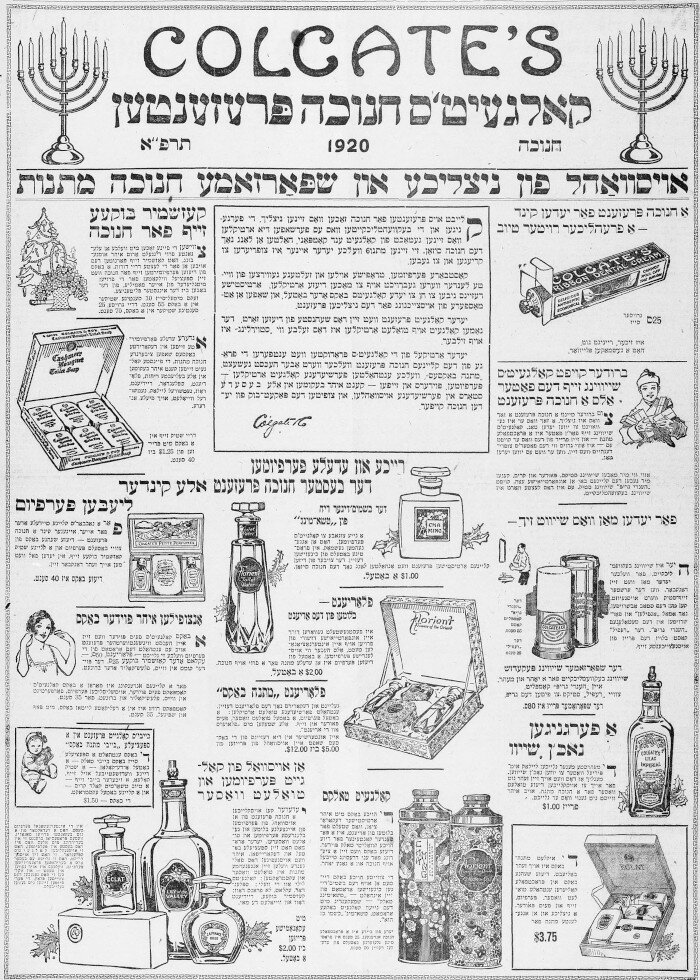Hanukkah: celebrations, commerce, and progressive action
One hundred years ago today… It was the fourth day and fifth night of Hanukkah, and several celebrations were underway, for example at synagogues in Ridgewood and Far Rockaway, Queens, and in Brownsville, Brooklyn. Most seem to have featured plays telling the Hanukkah story.
Brooklyn Daily Eagle, 12 December 1920, p. 55. Chronicling America,
In 1920, Hanukkah, like many facets of Jewish life, had not quite arrived as mainstream discourse, and was not the commercial juggernaut of a holiday it would become–though it was on its way. Below is an advertisement in Yiddish, from the Yiddish-language daily the Forverts (which we featured in our June 20 post), pitching domestic products–perfumes, shaving cream, soap, and yes, toothpaste–as gifts.
The Forward, 9 December 1920, p. 9. National Library of Israel.
Is it odd to see an Xmas tree at the top of this ad? The explanation is simple: it is an exact reproduction of an advertisement, in English, for Xmas gift-giving.
Philadelphia Evening Public Ledger, 17 December 1920. Chronicling America.
Who knew that “All Children love Perfume”?
1920 NYC's newspapers, particularly the Brooklyn papers, were full of reports of Hannukah-related charitable acts, fund drives and food drives led by women, such as one by the Jewish Women's Organization led by their new president, Rose Brenner, or this one for the Pride of Judea Orphans’ Home in Brownsville.
Standard-Union, 12 December 1920, p. 43. Chronicling America.
A bit of history: Hanukkah was traditionally a minor holiday on the Jewish calendar until the late 19th Century, when it had been boosted by reform Judaism, a movement looking for celebrations with less religious and more cultural/historical identity; it was partially a way of competing with Xmas, which many reform Jews celebrated (see Feldberg). In the 1920s, it was not only rising in popularity as a Jewish version of Xmas, but also being linked to the rising Zionism and sense of a Jewish-American identity.
A local branch of the Zionist Organization of America held a Hanukkah celebration in Flatbush:
The Chat, 18 December 1920, p. 101. Chronicling America.
In 1920, this was all going on at the end of fifty years of intense Jewish immigration to the US, and in the face of intense antisemitic fervor that would lead to, among other things, quotas of Jewish immigrants as part of the 1921 and 1924 federal immigration reforms. 1920 was also the year that saw Henry Ford's popular antisemitic publishing series (which we have featured in several posts, such as that of October 11) and quotas on Jewish students imposed at numerous universities.
References/Further reading:
Ashton, Dianne. Hanukkah in America: A History. United States, NYU Press, 2013.
Feldberg, Michael. “How Christmas Transformed Hanukkah in America.” My Jewish Learning.
Tietjen, Lib. “Hanukkah – As American As Epl Pie.” Tenement Museum Blog. 3 December, 2019.
– Jonathan Goldman, December 8, 2020
Special thanks to assistance with this article to Alisa Braun, Academic Director of the Jewish Theological Seminar, film scholar and educator Eric Goldman, and to Samuel Norich, President of the Jewish Daily Forward.
TAGS: Jewish, Judsaism, holidays, commerce, advertising, shopping, domestic products, charity, newspapers,





